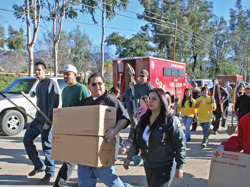
The late Serrano spiritual leader Santos Manuel often spoke of the tradition of generosity illustrated by his parents, Helena and Antonio.
“My father Antonio, when eating deer meat, would cut off a piece and hand it to the hungry boys,” Manuel told anthropologist John Harrington in 1915. “He would point to the soup and tell them to have a drink. He would make arrows and give the boys four or five ready-made ones, telling them, ‘Go and hunt with these.’
“My mother gave poor women buckskin garments. Poor people would seek out Antonio and Helena and everybody loved and respected them for their generosity.”
Sharing is a trait indicative of most American Indian cultures, from the Wampanoag who reached out to European settlers on the East Coast, to the Potlatch traditions of Northwest tribes, to the Lakota spiritual leader Sitting Bull, who lived in self-imposed poverty.
So it comes as no surprise that American Indian communities operating the more lucrative tribal government casinos have, since passage of the Indian Gaming Regulatory Act of 1988, contributed hundreds of millions of dollars to surrounding non-Indian communities and other tribal nations.
IGRA lists as acceptable uses of casino revenue charitable giving along with government programs, economic development and the welfare of native citizens. The response from some tribes has been astonishing.
The Shakopee Mdewakanton Sioux Community, operators of Mystic Lake Casino Hotel in Prior Lake, Minnesota, has donated nearly $200 million to charitable organizations and Native American organizations over the past 13 years.
The San Manuel Band of Serrano Mission Indians of San Bernardino County, California, many of whom are descendants of Santos Manuel, has contributed more than $50 million to tribes and charities since 2001.
Shakopee and San Manuel illustrate the charitable giving of indigenous communities operating the approximately 17 percent of the nation’s 418 tribal casinos that, combined, generate 69.5 percent of the $26.5 billion in revenue won in 2009 by the Indian casino industry.
Shakopee is known for giving economic development grants to Indian tribes, along with nearly $400 million in loans. In January the tribe gave $1 million each to the Bois Forte Band of Chippewa Indians of Minnesota, the Crow Tribe of Montana, the Flandreau Santee Sioux Tribe of South Dakota, the Rosebud Sioux Tribe of South Dakota and the Spirit Lake Tribe of North Dakota.
“Our philosophy was that we wanted to help tribes get through difficult times or raise money to start or expand businesses,” Shakopee Chairman Stanley Crooks says. “We didn’t want to do some joint venture and share in their profits, but we wanted to make it easier for them to get the money they needed to do what they thought was right for their tribe, whether it’s economic development projects or job creation.”
As is the case with many of the more lucrative casino tribes, San Manuel would historically budget a set amount for charities and wait for the applications.
“It was a program driven by the nature of the requests,” says Jake Coin, executive director of public affairs. “The tribe had no real opportunity to set their own goals with regard to what they wanted to achieve through their community outreach.”
San Manuel has since established guidelines for giving that are based on the tribe’s culture and traditions, particularly its commitment to Serrano ancestral lands, a vast territory that includes most of San Bernardino County. The band’s ancestral lands dwarf its 800-acre reservation.
The main thrust of San Manuel outreach is to help ensure the health, education and economic well-being of residents of San Bernardino, Highland and unincorporated areas that make up Serrano territory.
“We took a look at the (community outreach) program and decided we do have important community goals we wanted to address, among them being to raise the quality of life for people in the Inland Empire,” Coin says.
The tribe has long-term relationships with Second Harvest, the Red Cross, Loma Linda University Medical Center and St. Bernardine Hospital. It has given millions of dollars to local schools, colleges and universities.
As is the case with Shakopee, a component of San Manuel giving includes other native nations.
When the devastating Rodeo-Chediski fire of 2002 wiped out 468,638 acres of valuable timber resources on the White Mountain Apache Reservation in Arizona, San Manuel quickly stepped forward to donate $1 million to help the tribe deal with the economic loss.
“What the San Manuel Indians did for the White Mountain Apache really touched the hearts of our leaders and all our people,” then-tribal Vice Chairman Johnny Endfield said.
When floodwaters in 2008 swept the Havasupai village of Supai, deep in the Grand Canyon, destroying a campground and obliterating the majestic Navajo Falls, San Manuel again donated $1 million to help restore the village.
San Manuel also stepped forward with $1 million contributions when wildfires ravaged Indian villages in Southern California, and when freezing temperatures gripped tribal communities in the Great Plains.
“We try to be good brothers and sisters to all tribes,” Vice Chairwoman Lynn Valbuena says. “When they have those problems, it hits home. We need to do what we can. There are no second thoughts. We move forward and we do it.”
Education is deemed by San Manuel Chairman James Ramos as crucial to individual development. So he took particular pride in the October 2004 opening of the Santos Manuel Student Union and Cross Cultural Center at California State University, San Bernardino.
The $18 million center, funded in part with $3 million from the tribe, was named after the tribal leader who in 1866 was driven out of the San Bernardino Mountains by a California militia, leading 30 members of the Yuhaviatam Clan of the Serrano Indians to the valley floor, where the San Manuel Reservation is now located.






